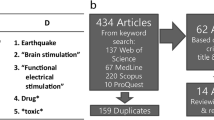Abstract
This paper describes a new treatment for essential tremor. A wearable orthosis, which can be adapted to each configuration of each joint of the upper limb, is able to apply effective dynamic force between consecutive segments of the upper limb and change its biomechanical characteristics. The orthosis is controlled by a computer with a dedicated software application that distinguishes between real time tremor and voluntary movement. The wearable orthosis is able to detect position, rate and acceleration of rotation of the joint by means of a chip gyroscope. This technology was evaluated in six patients suffering from essential tremor. The technique is non invasive and represents an alternative to medication and deep brain stimulation.
Similar content being viewed by others
References
Findley LJ, Koller WC. Definitions and behavioral classifications. In: Findley LJ, Koller WC, editors. Handbook of tremor disorders. Marcel Dekker, New York, 1995, pp 1–5.
Louis ED, Honig LS, Vonsattel JP, Maraganore DM, Borden S, Moskowitz CB. Essential tremor associated with focal nonnigral Lewy bodies: A clinicopathologic study. Arch Neurol. 2005;62:1004–07.
Benito-Leon J, Bermejo-Pareja F, Morales JM, Vega S, Molina JA. Prevalence of essential tremor in three elderly populations of central Spain. Mov Disord. 2003;128:389–94.
Louis ED. Behavioral symptoms associated with essential tremor. Adv Neurol. 2005;96:284–90.
Hua SE, Lenz FA. Posture-related oscillations in human cerebellar thalamus in essential tremor are enabled by voluntary motor circuits. J Neurophysiol. 2005;93:117–27.
Manzoni D. The cerebellum may implement the appropriate coupling of sensory inputs and motor responses: Evidence from vestibular physiology. Cerebellum. 2005;4:178–88.
Gibson AR, Horn KM, Pong M. Activation of climbing fibers. Cerebellum. 2004;3:212–21.
Glickstein M, Waller J, Baizer JS, Brown B, Timmann D. Cerebellum lesion and finger use. Cerebellum. 2005;4: 189–97.
Manto MU. The wide spectrum of spinocerebellar ataxias. Cerebellum. 2005;4:2–6.
Klebe S, Stolze H, Grensing K, Volkmann J, Wenzelburger R, Deuschl G. Influence of alcohol on gait in patients with essential tremor. Neurology. 2005;65:96–101.
Pagan FL, Butman JA, Dambrosia JM, Hallett M. Evaluation of essential tremor with multi-voxel magnetic resonance spectroscopy. Neurology. 2003;60:1344–7.
Manto M, Laute MA, Pandolfo M. Depression of extracellular GABA and increase of NMDA-induced nitric oxide following acute intra-nuclear administration of alcohol in the cerebellar nuclei of the rat. Cerebellum. 2005;4:230–8.
Ushe M, Mink JW, Revilla FJ, Wernle A, Schneider Gibson P, McGee-Minnich L, Hong M, Rich KM, Lyons KE, Pahwa R, Perlmutter JS. Effect of stimulation frequency on tremor suppression in essential tremor. Mov Disord. 2004;19:1163–8.
Binder DK, Rau G, Starr PA. Hemorrhagic complications of microelectrode-guided deep brain stimulation. Stereotact Funct Neurosurg. 2003;80:28–31.
Burkhard PR, Vingerhoets FJ, Berney A, Bogousslavsky J, Villemure JG, Ghika J. Suicide after successful deep brain stimulation for movement disorders. Neurology. 2004;63:2170–2.
Adelstein B. Peripheral mechanical loading and the mechanism of abnormal intention tremor. PhD dissertation, MIT, 1981.
Riviere CN. Adaptive suppression of tremor for improved human-machine control. PhD dissertation, Johns Hopkins University, 1981.
Michaelis J. Introducing the neater eater. Action Res. 1988;6:2–3.
Hendriks J. A second-generation joystick for people disable by tremor. In: Proceedings of the 14th Annual RESNA Conference. Elmsford: NY, Ed, RESNA Press, 1991. pp 248–51.
Rosen MJ, Arnold AS, Baiges IJ, Aisen ML, Eglowstein SR. Design of a controlled-energy dissipation orthosis (cedo) for functional suppression of intention tremors. J Rehabil Res Dev. 1995;32:1–16.
Kotovsky J, Rosen MJ. A wearable tremor suppression orthosis. J Rehabil Res Dev. 1998;35:4.
Manto M, Rocon E, Pons J, Davies A, Williams J, Belda-Lois JM, Normie L. An active orthosis to control upper limb tremor: The Drifts Project (Dynamically Responsive Intervention For Tremor Suppression). EURO-ATAXIA Newsletter. 26 November 2006, 2–6.
Rocon E, Ruiz AF, Pons JL, Belda-Lois JM, SanchezLacuesta JJ. Rehabilitation robotics: A wearable exo-skeleton for tremor assessment and suppression. In: ICRA05. 2005 International Conference on Robotics and Automation.
Struppler A, Erbel F, Velho F. An overview on the pathophysiology of parkinsonian and other pathological tremors. In: Desmedt JE, editor. Physiological tremor, pathological tremors and clonus. Progress in Clinical Neurophysiology. 1978;5:114–28.
Belda-Lois JM, Vivas MJ, Castillo A, Peydro F, Garrido JD, Sanchez-Lacuesta J, Barberá R, Poveda R, Prat J. Functional assessment of tremor in the upper-limb. In: Proceedings of the 8th Congress of European Federation for Research in Rehabilitation, Ljubljana, Slovenia, 2004.
Perlmutter JS, Mink JW. Deep brain stimulation. Annu Rev Neurosci. 2006;29:229–57.
Chen H, Hua SE, Smith MA, Lenz FA, Shadmehr R. Effects of human cerebellar thalamus disruption on adaptative control of reaching. Cereb Cortex. 2005;15.
Obayashi S. Possible mechanism for transfer of motor skill learning: Implication of the cerebellum. Cerebellum. 2004;3:204–11.
Nowak DA, Hermsdorfer J, Rost K, Timmann D, Topka H. Predictive and reactive finger force control during catching in cerebellar degeneration. Cerebellum. 2004;3:227–35.
Diedrichsen J, Hashambhoy Y, Rane T, Shadmehr R. Neural correlates of reach errors. J Neurosci. 2005;25:9919–31.
Kawato M, Wolpert D. Internal models for motor control. Novartis Found Symp. 1998;218:291–304.
Lin DC, Rymer WZ. Damping actions of the neuromuscular system with inertial loads: Soleus muscle of the decerebrate cat. J Neurophysiol. 2000;83:652–8.
Fahn S, Tolosa E, Marin C. Clinical rating scale for tremor. In: Tolosa E, Jankovic J, editors. Parkinson’s disease and movement disorders. Baltimore: Urban & Schwarzenberg, 1998.
Author information
Authors and Affiliations
Corresponding author
Rights and permissions
About this article
Cite this article
Rocon, E., Manto, M., Pons, J. et al. Mechanical suppression of essential tremor. Cerebellum 6, 73–78 (2007). https://doi.org/10.1080/14734220601103037
Issue Date:
DOI: https://doi.org/10.1080/14734220601103037




